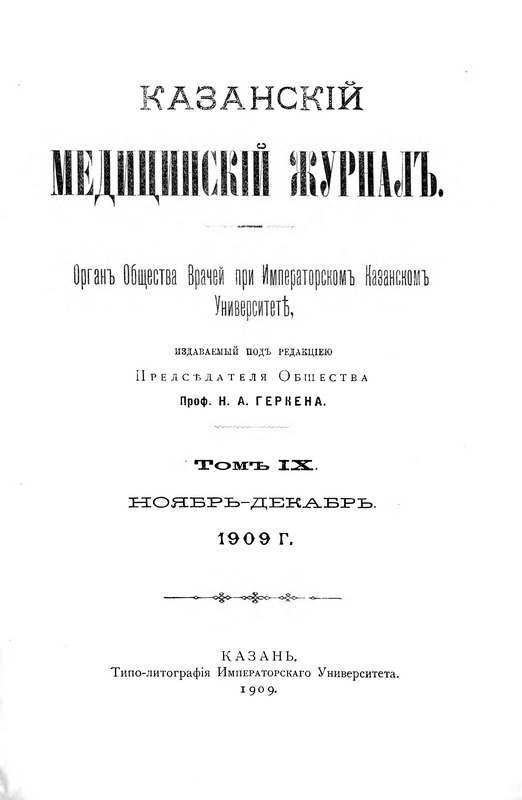Vol 9, No 11-12 (1909)
- Year: 1909
- Published: 11.11.1909
- Articles: 5
- URL: https://kazanmedjournal.ru/kazanmedj/issue/view/2905
Full Issue
On causes of the appendix morbidity
Abstract
Vermicular appendix inside our body, which does not look good, causing a lot of troubles to a more cultured mankind, remains a physiological mystery to us. Some ascribe to the appendix a major functional role at the completion of the digestive act, while others completely deny it.
 487-518
487-518


Liver abscesses as a complication of appendicitis
Abstract
One of the program topics designated by our Society in the cycle of works on appendicitis is also the study of those complications in the internal organs, which develop during appendicular attacks or as a result of inflammation of the appendix. I was instructed to briefly speak about purulent pylephlebitis with liver abscesses, which fortunately are not frequent complications of appendicitis.
 519-547
519-547


Appendicular abscesses
Abstract
Abscesses in the right iliac fossa are believed to have been known to physicians from ancient times. In the 18th and 19th centuries, there were stories of illness, drawing a picture of pustules, of appendicular origin, and some observers of that time call these boils peritonitis mascularis or psoitis, while others describe them as "posterior processes or uterine abscesses".
 548-556
548-556


About subphrenic abscess
Abstract
The issue of subphrenic abscess was of equal interest to both therapists and surgeons, and since the time of Bamberger's research, it has caused a large literature, which has been collected in Tillmans' (1882) works since the old days. Especially familiarity with this issue has moved forward a lot, thanks to the works of Leyden (1880) and especially Maudl, who collected a sick casuistic material in his monograph (1894). Great material was also collected by Grüneisen from the department of prof. Kërte (1902) Sachs from the clinic of prof. Kocher (1895) and Weber from the department of prof. Sonnenburg.
 557-566
557-566


Histology and physiology of the vermiform appendix in humans
Abstract
Histology. The vermiform process in its structure is closest to the large intestine. Its walls are formed by four membranes: 1) mucous membrane (tunica mucosa), 2) submucosa (tela submucosa), 3) muscular (tunica muscularis) and 4) outer, peritoneal membrane (tunica serosa).
 567-582
567-582











